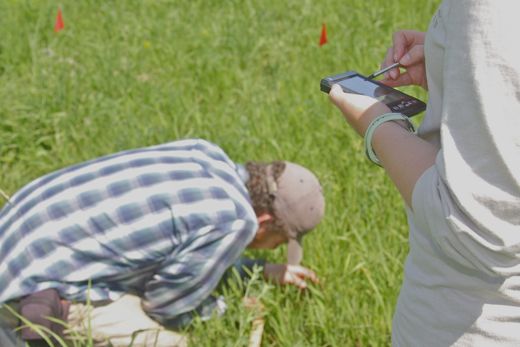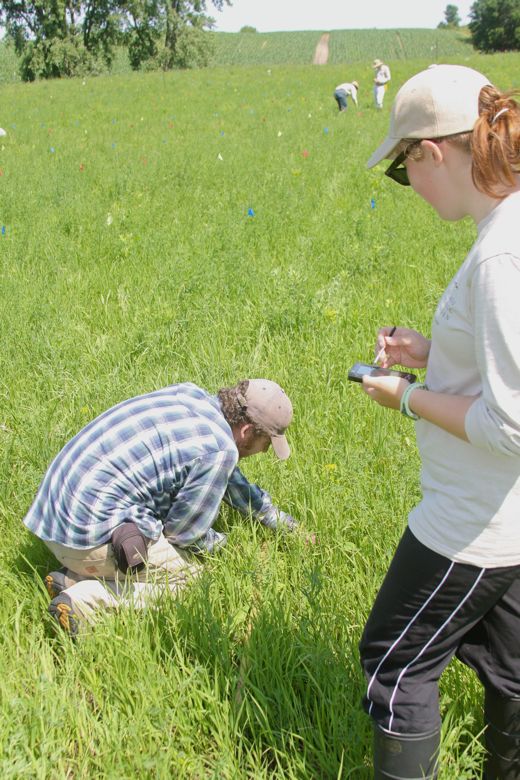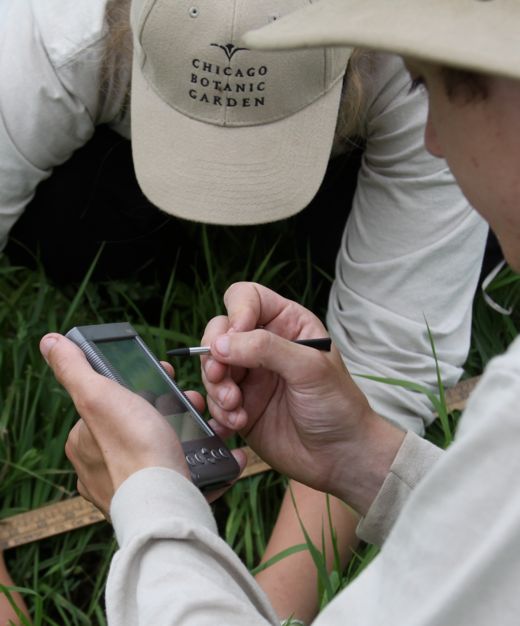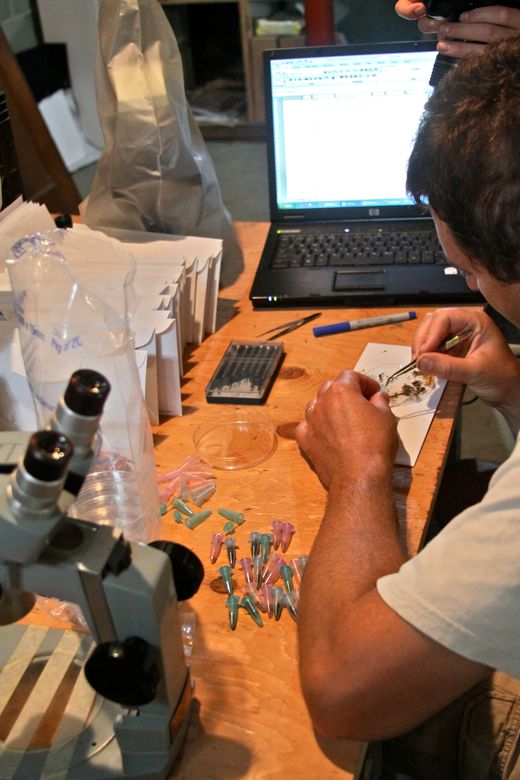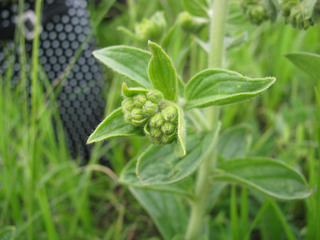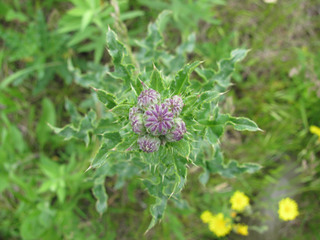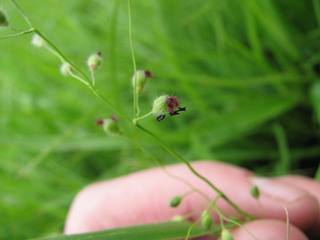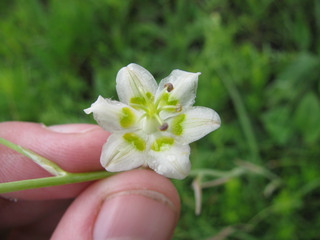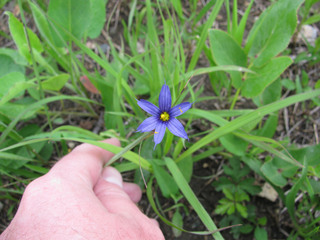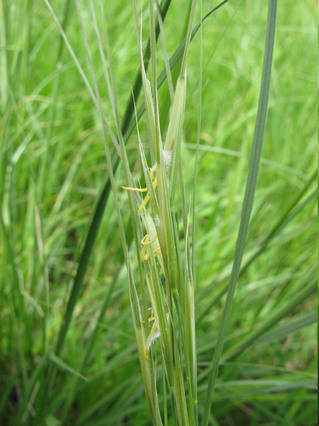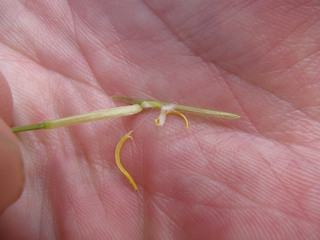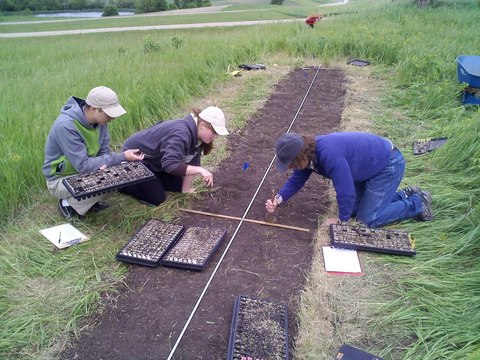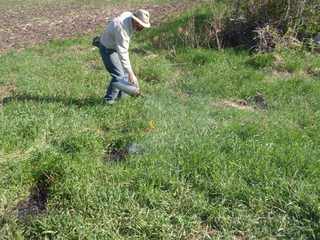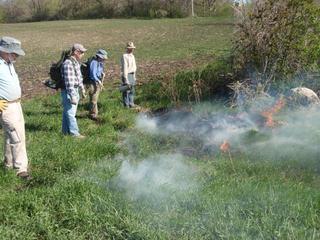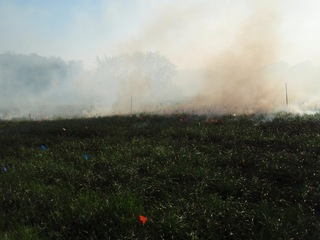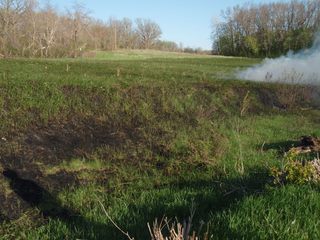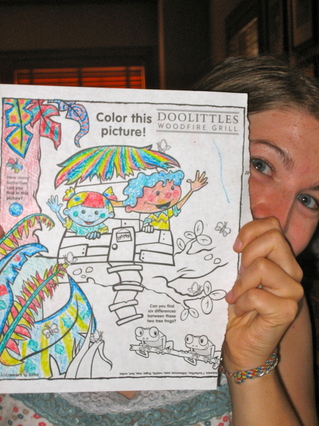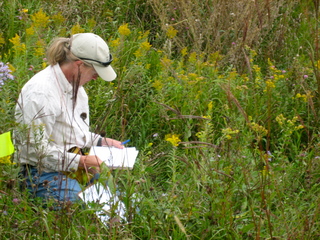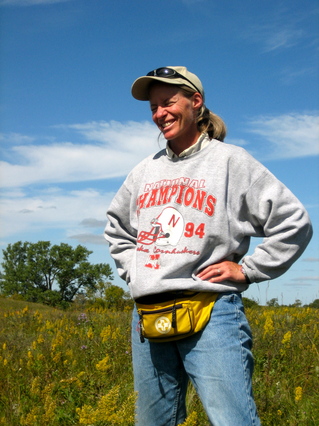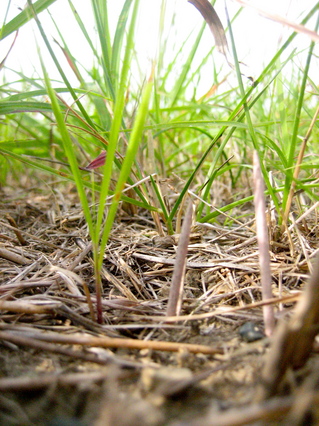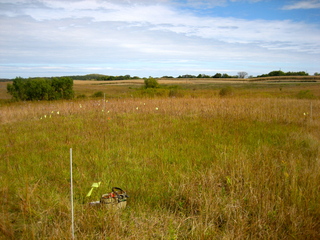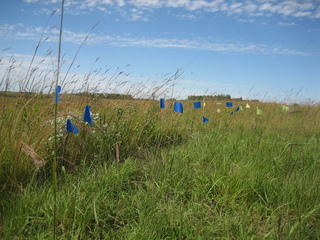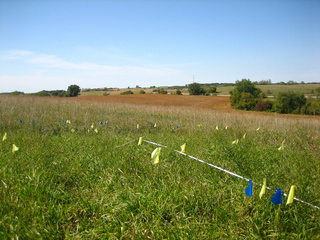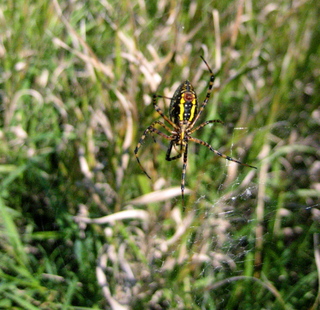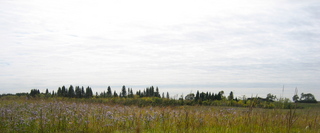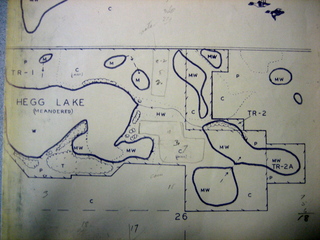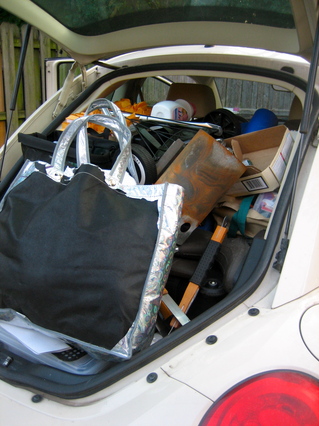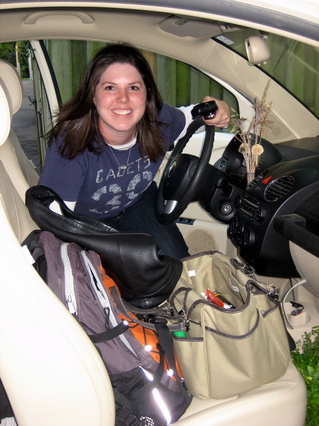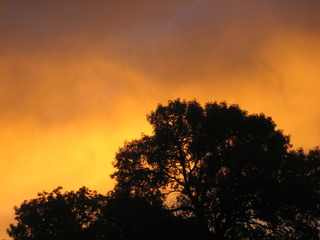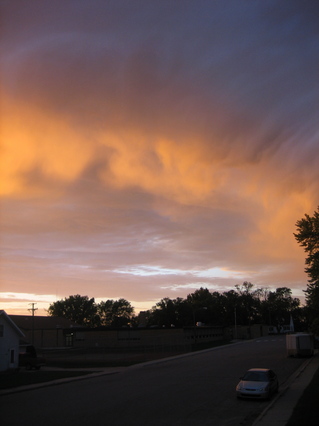Team Echinacea got a lot done this past week. On Monday we finished seedling searches, and on Wednesday we finished recruitment surveys. We’ve also made a lot of progress with the New Media Initiative: We now have a Facebook page and a Twitter account.
Then on Thursday, we started stipa searches. We looked in the Common Garden experimental plot for stipa that were planted as seed in the past two years. This means we were looking through bunches of grass to find this one specific kind of grass, which posed quite a challenge. As Stuart put it, it’s like looking for a needle in a needlestack. But we persevered! We found quite a few stipa plants, and will continue searching this week.
We also began aphid searching, as Katherine mentioned. I was glad that I didn’t find too many aphid infestations on our lovely Echinacea plants. It was a very satisfying way to end the work week.
Over the weekend, we had a 4th of July potluck-picnic celebration at Elk Lake. The food was all so delicious! And a construction team directed by Per made a formidable sandcastle fortress. Below are some pictures that Maria took. Happy (belated) 4th everyone!
|
||||
CategoriesExperiments
|
This week was much less strenuous than the last, thanks to a bout of rainy weather. Monday we took advantage of a dry day to conduct seedling searches and re-flag the common garden. Tuesday and Wednesday were too soggy for field work, so we stayed inside to work on independent projects and the new media initiative. Things finally dried up by Thursday afternoon, much to the relief of the antsier among us. That afternoon we learned how to conduct seedling recruitment surveys. These surveys are part of a long-term study to assess how Echinacea populations establish and persist in restorations (see Wagenius et al. 2011). Friday we conducted seedling searches at several sites (Landfill, NW of Townhall, and Staffanson Prairie Reserve) and planted seedlings at Staffanson. That about brings us up to date, workwise. On Saturday we took a trip to Alexandria and enjoyed the wonders of the Runestone Museum. Callin took some delightful photos that he will share here shortly. Hey everyone, I’m Maria, making my first appearance on the flog. I’m from Malaysia, currently a sophomore/rising junior at Northwestern. Sorry for the late first post as I’ve been unable to get onto the flog until yesterday 🙂 I’m now sitting beside Amy Dykstra out on the porch of Hjellm house enjoying the scenery while freezing in the cold. We have not been able to go out to do field work since Tuesday afternoon(?) due to wet weather, but we’re going to go out and plant the remaining <20 seedlings at Staffanson after lunch and perhaps seedling searches. Hope that the ground dries up! Anyway, here’s the link to the googledoc of my summer project proposal. I’m constantly updating it/working on it so it seems most practical to share it as a googledoc. Any input will be highly appreciated 😀 Hope that everyone will be able to assess the link. Let me know if the link is not working! Thanks! *Update June 24: The googledoc link is updated. Everyone should be able to assess it now 🙂 Maria Wang | June 23rd, 2011 | Category: project proposals, stories from the field, team member profiles | Leave a comment We went out to Hegg Lake for a plant-seeing adventure on Wednesday. Click the pictures to embiggen. First of is some Onosmodium, a marbleseed. A garter snake. Stuart knew the latin name but my memory isn’t that good. Penstemon grandiflorus, what are you doing here? You’re not native to this area! Spiderwort, a Tradescantia. A nice find. Dichanthelium is in flower! There’s quite a bit of it this year. Polygala senega was on top of a hill. Death camas (Zigadenus). Watch out. Sisyrinchium. These are blue, unlike the white ones I’ve seen at Staffanson Deer flies. These suckers hurt when they bite. Stipa is in flower! You can see the parts pretty clearly here. Interestingly, the diaspore is pretty much fully formed by the time pollination is happening. This makes sense, as it’s all maternal tissues apart from the seed itself. You can see it on Greg’s hand. Josh Drizin | June 19th, 2011 | Category: Photos | Leave a comment I was nervous when I entered the idyllic enclave of Kensington, MN. Here I was, after five days of driving from San Francisco, launching myself into a new place with new people, without knowing what to expect. I’m pleased to say that I am happy with my decision to join team Echinacea. On Monday, June 12th we began planting seedlings in Staffanson prairie reserve. This was part of a study on how burning plots affects the next generation of plants. Amazingly, we managed to finish the entire plot on Tuesday, thanks to the efficient cooperation of eleven people. Wednesday was too rainy for field work, so we spent the morning cleaning up and organizing our materials. After lunch we took a field trip to visit various sites and explore the flora therein (Josh snapped some wonderful pictures and will post them here soon). Over Thursday and Friday we completed seedling searches in three remnants: RI, KJ, and NESS. At each site we flagged a subset of Echinacea plants and pairs of team members searched for seedlings around each plant, mapping their results so we can find them again in the future. Cheers, Katherine Katherine Muller | June 18th, 2011 | Tags: weekly update | Category: stories from the field | Leave a comment Hey, it’s Josh again (I’m back! I’ll have a reintroduction post soon). We’ve had quite the productive week while Stuart was back in Chicagoland. With the help of awesome folks like Nicholas, Amber, and Callin, my garden is all dug up, weeded, planted, and watered. Now we wait (and water). We also took care of the seedling searches at EELR, NWLf, and NNWLf, not to mention extending the lines of the Staffanson common garden to 100m and marking them. Josh Drizin | June 9th, 2011 | Category: stories from the field | One comment Yesterday we burned the common garden. There was a lot of fuel, since the common garden was last burned in May 2008. It was a slow, even burn. Second photo: We doused the back fire with water, allowing the head fire to proceed west-ward across the common garden. Third photo: View from the northeast, looking southwest. The dark green in the foreground has already burned. Fourth photo: View from the northwest. It was a good burn! Voila the Echinacea 2010 Cookbook! Wow! This month has just flown by! It’s hard to believe that September is almost over, and so many things have happened. Let me explain. No. It’s too much. Let me sum up: Josh and Hillary had their last day on the 3rd. But before they left we: visited the county fair and saw lot’s of farm animals, visited Morris, and went out to a restaurant for dinner where Hillary created some beautiful art (see picture below). I think she has a great future in the creative arts. After they left, Amy and I worked very hard on seedling rechecks. Unfortunately, the weather was not always in our favor, but we persevered: I also spent a significant amount of time gathering my final data for both my seedlings and plugs: I finished my last bit of measuring on the 14th. Bob Mahoney’s site has a ton of spiders. I’m not usually very squeamish, but these guys are huge! So as you all know (I hope), I planted both plugs and seeds at three locations in Kensington: Hegg Lake, Runestone, and Bob Mahoney’s. One of the goals that I had for the summer was to find out what I could about these three locations. The site history; what they were planted with and how they were managed. After I finished my final data collection, I was finally able to take some time away to focus on these questions. I visited the Wildlife Management Office (Runestone) in Fergus Falls and the Department of Natural Resources (Hegg Lake) office in Glenwood. In Fergus, I met with Kevin Brennan and Chad Raitz, who were both very knowledgeable and helpful. I learned that the Runestone site is old farmland that was purchased in 1988. It was planted with corn in 1989, and with soy in 1990 and 1991, before being seeded with natives. The warm season grass seeds were harvested from a number of sites within a 50mi radius of Runestone, but the cool season grasses were purchased. Apparently, the gov’t offices can usually harvest their own warm season grasses, but have a harder time with cool season grasses because 1) their harder to find and 2) they don’t have the manpower off-season to go collect the seed. I also learned that in general, they don’t usually plant forbs, or rather they don’t go out and harvest forbs specifically. They do bulk harvests at prairie remnants and previous restorations and if they get forb seed that’s great, but they don’t go out specifically to gather forb seed. This makes me wonder about how successful a prairie restoration can be if the entire community assemblage isn’t present. How often do they go to harvest, what species are they missing? etc. Chad also told me that some of their harvesting sites are now being invaded with Tansy and parsnip, and so they can’t use those sites anymore. But he didn’t think they were working to fend off the invasion, again he sited lack of manpower. Kevin Kotts at the DNR was also very helpful. He pulled out all of the files on the Hegg Lake site and let me wade through them. I learned a lot about the DNR, their management practices, and a bit about the politics involved in creating a wildlife refuge like Hegg. It turns out that the DNR’s purchase of the Hegg Lake site was quite controversial. The land was purchased in two parts, but the bulk of it was sold by Mel Hagen for $12,500 back in 1961. Another smaller section was purchased in 1962 from a Mrs. Viola Brown. However, before the land could be purchased, the sale had to be approved by the Douglas County Commissioners, and it wasn’t. Much of the land at Hegg was in crop production, and thus was on the tax lists, and the commissioners didn’t want to loose productive land to wetland restoration. One commissioner claimed that Douglas County already had “enough ducks”! John Scharf, the Area Game Manager for the DNR, had to work for a solid year to get the purchase approved. He wrote in one of his many letters that, “their narrow-minded approach left [him] in a foul mood.” (Pun intended?) Once they had the land, the DNR focused more on restoring the wetlands than the upland prairie areas at Hegg. Much of the site actually remained cropland for years after the initial purchase. The area where my site was located was finally restored in 1998 and planted with native seed harvested in the Fergus Falls area, at least that’s what Kevin thinks. Despite all their files on the subject, there wasn’t any firm paperwork on the actual restoration of that portion of Hegg. Nevertheless, I got took some interesting pictures and found out some interesting information about the site. On September 17th, I was able to drive into Minneapolis-St.Paul to visit the University of Minnesota one last time. I met with a number of really interesting professors there. University of MN definitely has a great faculty and some very interesting programs! After my meetings, I met Amanda (from 2009 crew) for dinner. It was great to catch up with her and also to discuss the pollinator study we’ve both been working on for over a year now. We will get this project published by hook or by crook! That night Amy let me crash at her place before driving back to Kensington. I finally met Brad! I felt like I knew the man, but I’d never actually met him. I also met Mr. Bird, and let me tell you, that was an honor! Mr. Bird is quite the personality. So, THANK YOU AMY AND BRAD for letting me spend the night! On September 20th I drove back to Chicago! I was surprised to find temperatures in the 80s here in Chicago, when I had been, slowly, getting used to temperatures in the 50’s and 60’s up in MN. Here’s my car all packed for the way home:
Two last pictures of a beautiful MN sunset: Thus ends a very successful field season! |
Recent PostsArchives |
||
|
© 2024 The Echinacea Project - All Rights Reserved - Log in Powered by WordPress & Atahualpa |
||||





